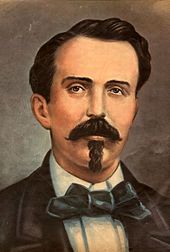Carlos Manuel de Céspedes
Carlos Manuel de Céspedes y López del Castillo (born April 18, 1819 in Bayamo , Cuba ; † February 27, 1874 in San Lorenzo , Cuba) was a Cuban freedom fighter and largely responsible for the outbreak of the first Cuban war for freedom ( Ten Years War ). He is considered the founder of the Cuban nation and was its first president.
Life
On October 10, 1868, the large landowner CM de Céspedes called on all Cubans to fight against the Spanish colonial power ( Grito de Yara ) from his La Demajagua sugar mill in Manzanillo . He released all of his slaves and invited them to join the fight.
On April 10, 1869 he was elected president of the group formed in the underground Cuban Republic elected (Asamblea de Guáimaro) .
After his removal as president (October 27, 1873), his departure into exile was prevented by the new Cuban government because they refused to give him an escort.
Death and afterlife

In 1874 Céspedes was killed in action with the Spanish colonial troops after his hiding place was betrayed. His body was publicly exhibited in Santiago de Cuba by the Spanish colonial power and buried in a mass grave. His remains were recovered from the mass grave in 1910 and transferred to a tomb in the Santa Ifigenia cemetery.
Céspedes is popularly referred to as the father of the fatherland because, when his son was captured by Spanish soldiers, he decided not to stop the fight and exchange his son, with the words: "All Cubans are my sons". His son was then killed by the Spaniards.
His portrait is depicted on the CUP 100 banknote, his monument in Havana on the CUC 100 banknote.
| personal data | |
|---|---|
| SURNAME | Céspedes, Carlos Manuel de |
| ALTERNATIVE NAMES | Céspedes y López del Castillo, Carlos Manuel de (full name) |
| BRIEF DESCRIPTION | Cuban freedom fighter, founder of the Cuban nation |
| DATE OF BIRTH | April 18, 1819 |
| PLACE OF BIRTH | Bayamo , Cuba |
| DATE OF DEATH | February 27, 1874 |
| Place of death | San Lorenzo , Cuba |

